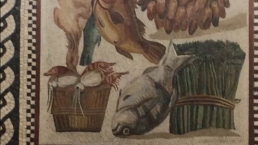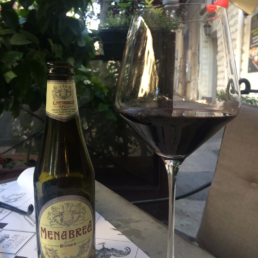In my upcoming book Obedient unto Death, describing meals eaten 2000 years ago can prove interesting. In a previous blog, I discussed the seating chart at a Roman dinner party—the host assigned places based on the order of your status or popularity. The menu reinforced the importance of the visitors. The more the host was trying to impress, the fancier and more expensive the food. The slaves laid out the best silver, and if the family was extremely wealthy, crystal goblets. Some customs have not changed much.
We would recognize most of the foods and dishes the ancient Romans ate. A variety of lettuces was a typical appetizer that helped digestion, followed by vegetables and legumes, including leeks, squashes, radishes, cucumbers, and onions. Eggs of all varieties, chicken, quail, and pheasant, were a favorite hors d'oeuvre. A complementary wine, sweet, watered down, spiced, honeyed, heavy, or light, was chosen for each course.
Meat was a luxury that only the rich enjoyed. And although boar, goat, stag, veal, rabbit, fish, and poultry are still staples of many meals today, eating dormouse, a favorite rodent similar to eating squirrel or raccoon, is on the fringe of most modern diets.
Anthony Bourdain introduced me to worldwide cuisine delicacies, so it is not surprising that the Romans ate eel, sea urchin paste, and fish eyeballs, but some recipes gave me pause. Try a sow's udder in brine flavored with tuna sauce or vegetables with calf brain pudding. How we prepare our food and which parts we eat are where our palates might diverge from the ancients.
Those of you familiar with Roman literature will recognize the fish sauce GARUM. The Romans used it like we use catsup, mayonnaise, cheese sauce, dipping sauce, tartar sauce, hollandaise sauce, you name it. Recipes varied depending on where you lived in the empire, but all versions began with a small fish's puree. The entire fish was pounded, spiced, fermented, strained, and bottled for future use. "The finest garum was made of the livers of the fish only, exposed to the sun, fermented, and somehow preserved. It was an expensive article in old Rome, famed for its medicinal properties." (1) It has been called the "essence from putrefied intestines of fish." (2) My mother fed me cod-liver oil as a child. Perhaps we are not so far from eating garum after all.
One of my favorite recipes to imagine is MILKFED SNAILS. 1.Pull snails from their shells and place them in a vessel with milk and salt for a day. Renew milk daily. When they are so fat, they can no longer crawl in their shells, fry them in oil and serve them with wine sauce.
Edible snail (Dr. Hagen Graebner, Wikipedia Creative Commons 2.5 license)
A customary way to prepare SHEEP LIVER OR LUNGS: 1. Soak well in milk, strain it off if offensive in taste. 2. Break two eggs, add salt, mix in a spoonful of honey and fill the lung with it 3. Boil and slice. (sorry no picture of this one, it made me gag.)
We cannot forget the desserts which the ancients loved as much as we do. Sugar was not available to the Romans, so honey was the main ingredient in sweets. Popular pastries filled with raisins, dates, nuts, berries, and fruits were not so different from our delicacies.
I shall leave you with a pearl of Roman culinary wisdom. Onions and the bulbs of tulips or narcissus boiled in water are conducive to love and suitable for wedding feasts. Bon Appetit.
1. Apicius, and Joseph Dommers Vehling. Apicius, Cookery and Dining in Imperial Rome: a Bibliography, Critical Review and Translation of the Ancient Book Known as 'Apicius De Re Coquinaria'. Dover Publications, 1977.
2. ibid.
More posts
January 26, 2025
0 Comments5 Minutes
Spectacles of Rome: Bathing, Blood, and Chariots (Part 1 Bathing)
July 3, 2024
0 Comments1 Minutes
Interested in Fortunes of Death book two in the Secrets of Ephesus series?
January 11, 2022
0 Comments7 Minutes
Christian Persecution
Christian persecution in 96 AD/CE, the era of "Obedient unto Death", was not an all-out war against Christians. The Romans, in general, were tolerant of diverse religions; What got Christians in…
January 13, 2021
0 Comments4 Minutes
It is Really Happening?
My new year started with a huge celebration!!!! CrossRiver Media accepted my historical mystery novel Obedient unto Death for publication, with a target launch date of December of 2021. Getting…
December 24, 2020
0 Comments5 Minutes
A Treacherous Topic part 2
I found no records of general concern to humanize the laws governing slavery. For the most part, the ruling class agreed slaves had no personal rights apart from those granted by their masters. This…
October 9, 2020
0 Comments1 Minutes
A writing journey: inspiration
I can't pinpoint the exact moment in my life when inspiration struck, and I knew I had to drop everything and write. Many writers say they knew they wanted to be an author the first time they picked…
October 9, 2020
0 Comments5 Minutes
Treacherous Topic part 1
When we attempt to relate to another culture, especially one existing over 2500 years ago, confusion, bewilderment, and in the case of slavery, rage is bound to happen. The culture of slavery is an…
August 30, 2020
0 Comments4 Minutes
If you eat with your fingers you might be a Roman.
In my murder #mystery novel “Obedient unto Death,” I needed to describe a formal Roman dinner. I have watched movies portraying Roman dinner parties, but watching and writing about them are two…
July 25, 2020
2 Comments2 Minutes
Providence – God’s Plan for Me
I have lost count of the times I have been astounded and amazed by God’s providence. I keep saying I should record all the miracles that have transpired, the “coincidences,” the “I can’t believe it”…
July 22, 2020
0 Comments4 Minutes
A Most Appreciated Bible Verse
At this juncture of life, Psalm 46:10 is the verse I find myself turning to again and again for reassurance, advice, and focus. “Be still, and know that I am God...” (KJV) This advice was front and…
March 31, 2019
0 Comments2 Minutes
Faith musings
I am sad today. A young hummingbird flew into our house yesterday, and the situation did not end well. We have cathedral ceilings, and it flew straight up to the 16-foot-high peak and stayed there.





























































